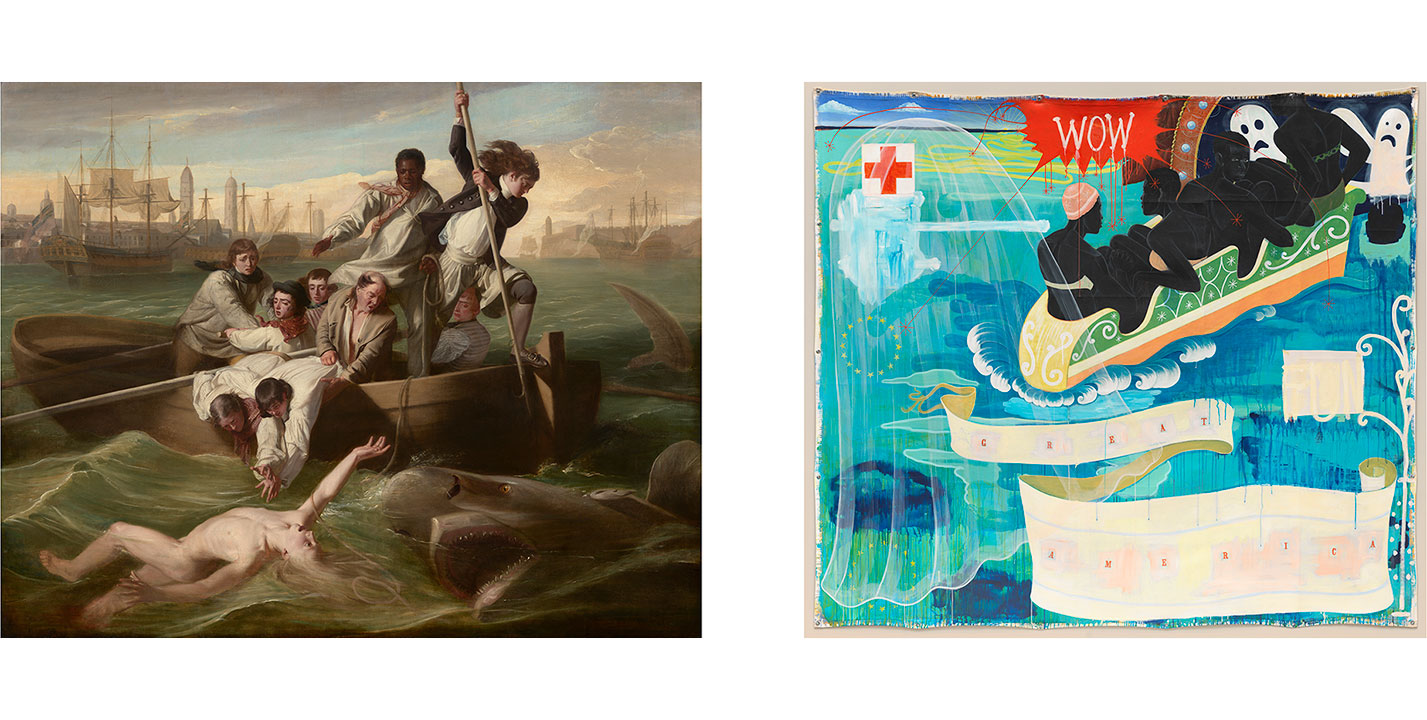Conversations: Kerry James Marshall and John Singleton Copley

left: John Singleton Copley, Watson and the Shark, 1778, oil on canvas, overall: 182.1 x 229.7 cm (71 11/16 x 90 7/16 in.), framed: 241.3 x 264.2 x 10.1 cm (95 x 104 x 4 in.), National Gallery of Art, Washington, Ferdinand Lammot Belin Fund; right: Kerry James Marshall, Great America, 1994, acrylic and collage on canvas, overall: 261.62 x 289.56 cm (103 x 114 in.), National Gallery of Art, Washington, Gift of the Collectors Committee
Conversations: Kerry James Marshall and John Singleton Copley
November 18, 2023–January 31, 2025
West Building, Main Floor, Gallery 60B
This installation brings together three landmark paintings of American art: Watson and the Shark by John Singleton Copley and Great America and Voyager by Kerry James Marshall. It illuminates how both artists—centuries apart—reimagined the practice of large-scale, multi-figure history painting in their own time. The installation is the second in the Conversations series at the National Gallery of Art, which aims to engage visitors and ignite curiosity about the museum’s permanent collection by bringing diverse works from different time periods into dialogue with each other.
Bridging the 18th and 20th centuries, this installation juxtaposes Copley’s and Marshall’s distinct reimaginings of history painting from their individual perspectives—Anglo-American and African American, respectively. Both artists imbued contemporary subject matter with cultural, religious, and mythological allusions that refer to wider historical crosscurrents.
Watson and the Shark is set in the major slave trading port of Havana, Cuba. The notable presence of an African crewman, whose identity is unknown, near the top of the composition suggests the key role that African sailors, both free and enslaved, played in 18th-century maritime commerce and culture. Brook Watson, the 14-year-old boy who survived the shark attack, later went on to serve in the British Parliament, where he opposed the abolition of the slave trade.
The comparison between Watson and the Black sailor initiates a powerful dialogue with Marshall’s Voyager—a representation of Wanderer, the penultimate slave ship to land on US shores (illegally) in 1858—and Great America, his depiction of contemporary African Americans surrounded by ghosts and a man overboard in an amusement park Tunnel of Love.
Supplemented by working drawings for Great America gifted by Marshall, all three paintings encourage visitors to consider how the violent history and persistent memory of the slave trade have impacted the various figures seen adrift on troubled waters in these resonant images, from the colonial and antebellum eras until the present day.
Organized by the National Gallery of Art, Washington
Contact Information
General Information
For additional press information please call or send inquiries to:
Department of Communications
National Gallery of Art
2000 South Club Drive
Landover, MD 20785
phone: (202) 842-6353
e-mail: [email protected]
Newsletters
The National Gallery also offers a broad range of newsletters for various interests. Follow this link to view the complete list.